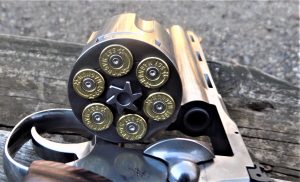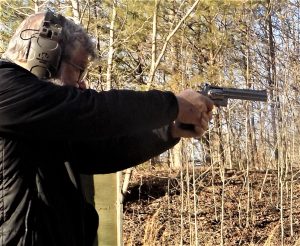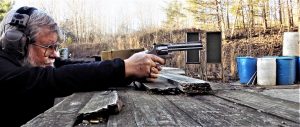By R.K. Campbell | Contributing Editor

The new Colt Python is a shooter, as confirmed by this target.
Bringing back the Colt Python was big news- and controversial among some shooters.
It may not be a respect and moral issue such as using Steve McQueen’s digitalized image in a new movie, or a tradition argument such as Porsche no longer offering a manual gearbox but it is pretty important.
Some seem concerned with losing value on their Python collection. I am a shooter not a collector and own Pythons I shoot and carry. I do not think your vintage Python will be adversely affected. After all vintage Colt 1911 handguns are bringing good prices despite the availability of good quality new production 1911 pistols. Then there are those that feel that the modern Colt may not possibly be as good a shooter as the older handguns.
I cannot guarantee that the older Pythons will keep their value or comment on the future availability of the new Colt Python but if you have any doubt concerning the quality and usefulness of the new Python I can put that to rest. The new gun is the better gun. It is a similar situation as when Colt introduced the new Cobra revolver. The new Colts are rugged reliable and useful revolvers. The new Python is much like the older Python but with good improvements.

Colt’s stainless steel cylinder is plenty strong for Magnum loads
So what has Colt done with the finest revolver ever produced? I have not seen a blue finish revolver and they may not offer one, but the stainless steel Python is a wonderfully finished revolver.
For those not familiar with the Colt Python the revolver was introduced in 1955. The Python was a deluxe revolver in every way intended to win competitions, take game, and serve for personal defense with no need for further modifications. The hand honed action and blue finish are exceptional. I am not certain that Colt could re- create the original Royal Blue, so a polished stainless revolver makes a world of sense.
The new Python is much the same as the original in that the balance is perfect. It is not a large frame revolver but neither is it a .38-frame revolver with the Magnum shoe horned into it. It is a .41 frame, ideal for a combination of weight absorbing recoil without dragging the trousers down when worn on the belt.
The Python went into semi-production as a custom shop revolver in 1999 and ceased production altogether in 2005. The new version has a number of improvements. Colt advertises an improved action with less parts. A weak spot of the earlier revolver- not making it a weak handgun but a concern in long term use- was a lock up that transferred recoil energy into the action.
All revolvers suffer a jolt when they are fired but the Colt’s ultra-tight lockup suffered more than others while maintaining exceptional accuracy as a byproduct. The rear sight is a stronger design in the new revolver and the top strap has been strengthened as well.
I have never seen a cracked top strap on a Colt but then folks hot rod their .357 Magnum handloads. The cylinder would have to blow first. I think Colt has made the Python more like the Ruger GP 100 in this regard. The Colt, however, is by far the smoother gun and it should be for twice the money. The new Colt should be more reliable in long term use and easier to service than the original Python. I don’t know if I will be able to fire enough cartridges to determine for certain but I will try.

The author fired the Colt double action almost exclusively.
The trigger action is a very smooth nine pounds. If I felt this action on an original Colt, I would say the action is too light to crack the primer. But it isn’t. The barrel now features a recessed crown, a good change. The new stocks fit my hand better than the original. The trigger and the hammer are very nice target types.
The chambering, .357 Magnum, is ideal for many uses. Target grade .38 Special loads are very accurate and offer a modest push on firing. Medium range Magnum loads offer good wound ballistics for personal defense. Heavy hunting loads are good for middle sized wild boar and deer sized game. In some ways the Magnum is a rifle on the hip. With that said the only way to gauge the Python’s performance was to fire it.
I took the new Python to the range with a good supply of ammunition, intending to work up from target .38s to the wildest Magnums. I began with Black Hills Ammunition .38 Special 148 grain wadcutter. This 775 fps load offers excellent accuracy potential.
A word on the Python action- you must understand how it is timed to coax the greatest accuracy from it. If you cock the hammer slowly in single action it seems to drag a bit and the cylinder may not be completely locked up. As you press the trigger the cylinder moves into lockup by the double hand and it is locked tightly when the hammer falls. Colt claims that since the cylinder rotates to the right this forces the cylinder into the frame, opposite of the Smith and Wesson.
The Colt definitely seems to exert more leverage on the cylinder than the Smith and Wesson or Ruger. The new Python has a cut out on the rear face of the cylinder I don’t quite get the purpose, but it doesn’t appear easy to machine, so it evidently is there for a reason. I have had the perception of the Colt as a hand fitted personal gun while other revolvers perhaps were better suited to general issue. The new Python reinforced this opinion.

A target sighted six-inch barrel deluxe revolver is a joy. The Python is the best made American revolver the author has tested.
A 46-ounce, six-inch barrel Magnum with high visibility adjustable sights is a joy to fire. During the test I drew from GALCO’s DAO holster, an excellent revolver holster that offers good security when hunting or hiking. This is a well made scabbard with excellent stitching and retention screws. The security strap features an extended tab at the lock that makes for rapid manipulation. This is the type of attention to detail that GALCO is famous for.
The target wadcutter load gave excellent results. A good rule is to fire twenty .38s for every Magnum and that is how the practice went. Firing double action, man sized targets are in danger well past 50 yards. Holding on the chin at 100 yards results in good hits in the lower half of the target. Firing from the Bullshooters pistol rest at 25 yards and using the six o’clock hold five shots went into 1 1 /8-inch average with a best group of 15/16-inch including three shots in 3/8- inch. The Colt made it easy.
I upped recoil with a handload using Matt’s Bullets 173-grain SWC over enough W231 for 1,050 fps. This is a stout .38 Special load that has often demonstrated excellent accuracy. I kept all shots in a palm sized spread at 25 yards, firing double action. I also used a 165-grain lead hollow point over enough Titegroup for 890 fps with good results.
Moving to .357 Magnum loads, I filled the chambers with the Black Hills Ammunition 125- grain JHP. This load breaks 1,420 fps in the four-inch Python and 1,503 through the six-inch barrel. I fired double action at 25 yards.
The new design grips fit my hand well and allows excellent groups. I also fired the Black Hills Ammunition 158-grain JHP at 1,348 fps. This is a potent load that drives deep and would make a good choice for deer sized game. I relaxed, rubbed my wrists, and decided to fire the Magnum loads for absolute accuracy at 25 yards this time cocking the hammer for single action fire.

Among the finest leather choices is the GALCO DAO. This is a great field holster.
The 125-grain load went into 1.4 inches and the 158-grain load averaged 1.1 inch for three five-shot groups, with one group measuring 0.85 inch at 25 yards. This is probably as good as I am able to hold without optics. A six-inch barrel target revolver is a joy to fire and use and the Python is more accurate than most.
I have much more to do to explore the capabilities of this first class revolver. Initial results are beyond expectation. If you have been wishing to own a Colt Python and finances and opportunity never met this is the revolver for you. It is a gun made for shooters. Best of all it cost half the price of the average vintage Python.
Colt Python prices have not been the result of manufacturing cost but of supply and demand and speculation based on the revolver being out of production. I don’t like this as the Python isn’t meant to be a collector’s piece but a revolver meant for shooters. At about $1,500 dollars, the new Python will put the finest revolver ever made in the hands of shooters once again.



